Businesses are constantly seeking innovative strategies to drive growth and gain a competitive edge. As the digital world has grown, one strategy that has gained significant attention is the concept of ad growth loops. This article will analyse the power of ad growth loops, exploring their definition, mechanics, building strategies, measurement, and future trends.
| Key Element | Description | Tips for Optimization |
|---|---|---|
| Ad Growth Loops | Marketing strategy that uses ads to drive sustainable business growth through reinvestment. | Iteratively improve ad campaigns using data insights and reinvest profits to acquire more users. |
| Key Mechanics | Focuses on attracting users, retaining and monetizing them, and reinvesting revenues in more ads. | Enhance user targeting, improve engagement, and efficiently reinvest to sustain growth. |
| Building Effective Ad Growth Loops | Involves strategic planning, execution, and continual optimization through analytics. | Encourage experimentation, use analytics for continuous strategy refinement. |
| Measuring Success | Track KPIs like customer acquisition cost, retention rate, and revenue growth. | Assess and adjust based on KPIs to enhance ROI and cost-efficiency. |
| Potential Challenges | Capital constraints, competitive risks, and audience dilution over time. | Diversify marketing, secure funding, and expand to new segments as needed. |
| Future Trends | Emergence of AI and machine learning to enhance ad targeting and user engagement. | Incorporate advanced technology to refine targeting and campaign performance. |
Understanding ad growth loops
Definition and function of ad growth loops
At its core, an ad growth loop consists of three fundamental elements: attracting new users through targeted advertising, ensuring their retention and monetization through engaging experiences, and reinvesting these revenues into additional advertisements.
By optimizing and fine-tuning each of these components, businesses can create a self-reinforcing loop that fuels revenue growth.
One key aspect of ad growth loops is the concept of data-driven decision-making. By analyzing user behavior and engagement metrics, businesses can gain valuable insights into what resonates with their audience and tailor their advertising strategies accordingly.
This iterative process of testing, measuring, and refining allows companies to continuously improve the effectiveness of their ad campaigns.
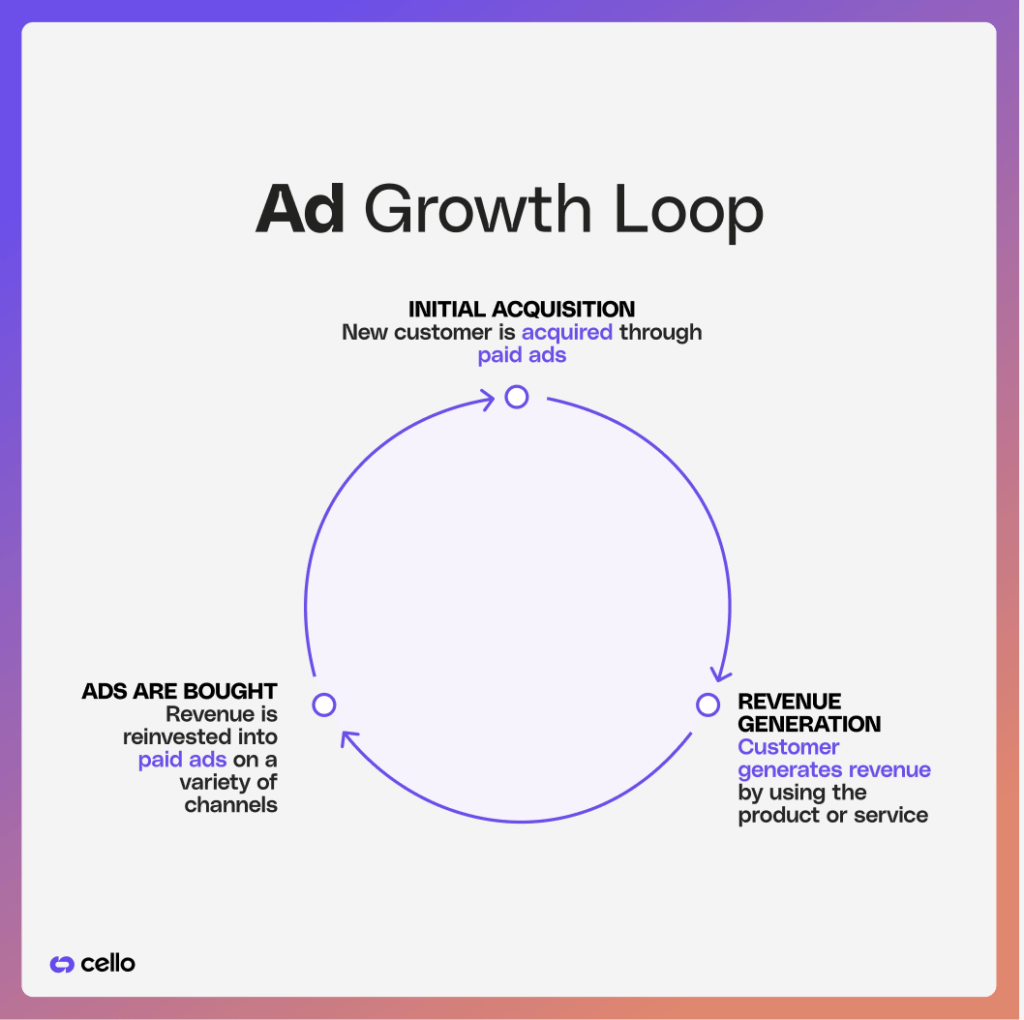
The importance of ad growth loops in marketing
In an era where user attention is scarce and competition is fierce, traditional one-off advertising strategies may no longer be sufficient to drive sustainable growth. Ad growth loops offer a distinct advantage by reinvesting generated capital into new ads to attract customers.
Unlike traditional advertising methods that focus solely on acquiring new users, ad growth loops prioritize both acquisition and monetisation.
This holistic approach ensures that businesses not only attract new users but also nurture and retain them, creating a loyal customer base. This, in turn, leads to increased customer lifetime value and enhanced profitability.
The mechanics of ad growth loops
The role of user acquisition in ad growth loops
In the realm of ad growth loops, user acquisition plays a pivotal role as the initial step in the process. This involves identifying and targeting relevant audience segments through various advertising channels.
By leveraging data-driven insights, businesses can optimize their campaigns to reach the right users at the right time, maximizing the efficacy of their ad spend.
But what does it take to truly excel in user acquisition? It's not just about acquiring any users; it's about acquiring high-quality users who are more likely to drive sustainable growth. This means going beyond mere quantity and focusing on the quality of users acquired.
Refining targeting parameters, utilizing lookalike audiences, and leveraging user behavior data are just some of the strategies businesses can employ to identify potential customers who align with their value proposition.
Think of Strava, a fitness tracking app. It is a reasonable assumption that it wants to acquire users who are not only interested in fitness but also have a high likelihood of becoming loyal customers. By analyzing user behavior data, Strava can identify individuals who have shown consistent interest in fitness-related content, have a history of using fitness apps, and have a higher probability of converting into paying customers.
This targeted approach ensures that the app's user acquisition efforts are not wasted on users who are unlikely to engage or monetize.
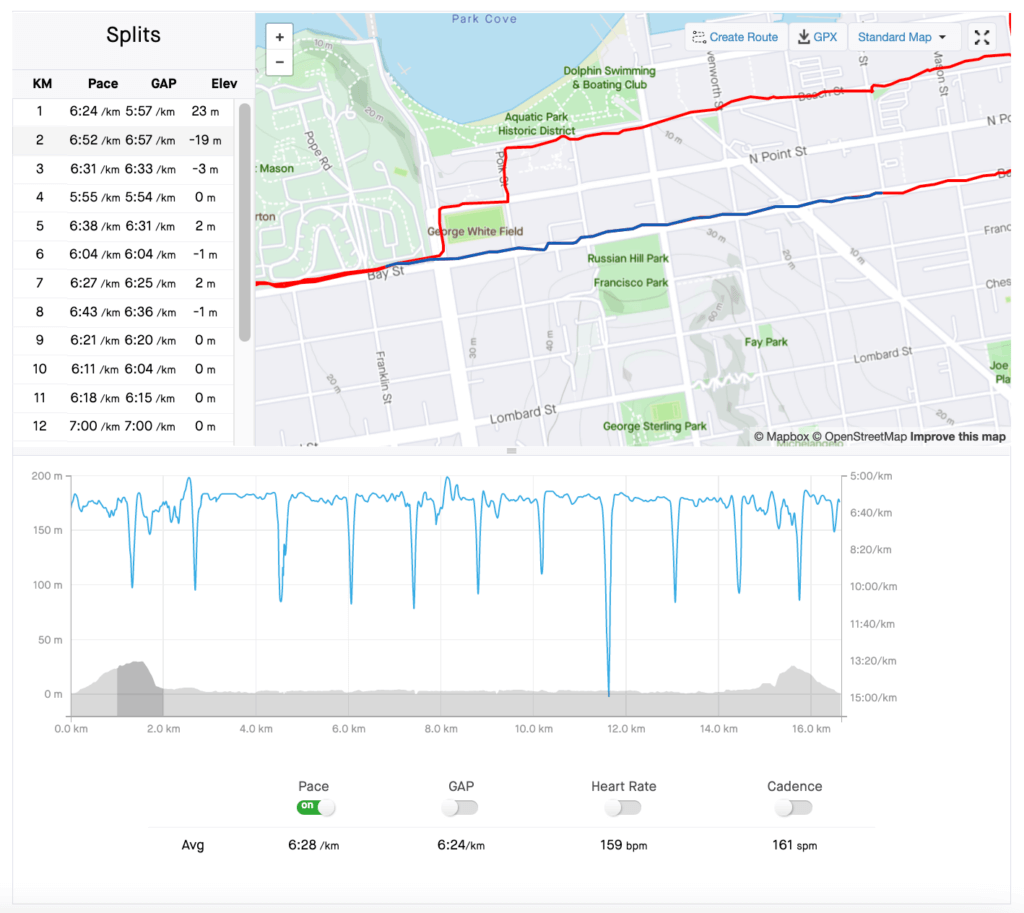
Retention and monetization in ad growth loops
While user acquisition sets the foundation, retention and monetization are essential for ad growth loops.
Retention
Retention strategies aim to maximize user engagement, minimize churn, and foster long-term loyalty.
This can involve:
- Personalized communication
- Targeted promotions
- Seamless user experiences
Amazon, an e-commerce platform, works on retaining its customers by offering personalized recommendations based on their browsing and purchase history. By analyzing customer data, the platform can create tailored product suggestions that align with each customer's preferences and interests. This not only enhances the user experience but also increases the likelihood of repeat purchases, ultimately driving revenue growth.

(Source: Mageplaza)
Monetization
Monetization, on the other hand, focuses on converting user engagement into tangible revenue streams. This can involve various monetization models such as subscriptions, in-app purchases, or advertising revenue.
By optimizing monetization strategies, businesses can generate consistent revenue and reinvest it into further ads for user acquisition and retention, thereby fueling the growth loop.
Let's take the example of Candy Crush Saga, a mobile game developed by King that offers in-app purchases to enhance the gaming experience. By carefully designing the in-app purchase options, the game can provide players with enticing upgrades that adds value to their gameplay. This both generates revenue, and keeps players engaged and invested in the game. As a result, the likelihood of them recommending it to their friends and expanding the user base increases, while revenues can be reinvested in ads.

Understanding the primary value promise
As previously covered in our piece on incentivized viral loops, there are three types of value promise.

- Intrinsic: Intrinsic value promises occur when a party receives personal utility from a product, service, or action.
- Extrinsic: Extrinsic value promises are usually related to monetary gains of a certain party.
- Social: Social value promises normally relate to social recognition and status gains of a party.
When it comes to ad growth loops, there are two main parties.
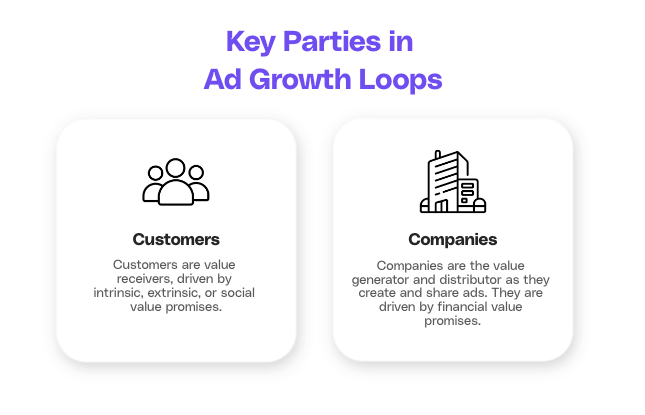
- Companies: this party plays the role of both the value generator and distributor, as they are responsible for creating and sharing the ads. The value promise for companies is financial, as they are trying to increase monetisation and revenues.
- Users and customers: this party is the value receiver, as users and customers are the ones using the product or service. The value promise for them may be intrinsic, extrinsic, or social, depending on the product.
Value proposition friction
In our piece on sales growth loops, we analysed three types of value proposition friction. This term fundamentally refers to how easy it is for customers to understand the value of the product or service you are offering, as well as the ease of getting started.
As a reminder, value propositions can be:
- Low: When the value of a product or service is very easily understood and implemented. This includes companies such as DoorDash and Zoom.
- Medium: When the value of a product or service is clear, but human support helps better understand the value proposition and as such converts customers. Moreover, getting started could take a bit longer. Examples include Sessions, a platform designed to simplify meeting stacks of companies.
- High: When the complete value of a product or service is not as intuitive and as such highly benefits from human distribution. Implementation and rollout are quite complex. This includes Adobe and Zoho.
Ad growth loops are ideal for low to medium value proposition companies, as they can influence audiences for such products. However, they can also be useful for high friction companies. In both scenarios, it is essential to combine them with other marketing efforts.
Building effective ad growth loops
Key components for successful ad growth loops
Creating effective ad growth loops requires careful consideration of various key components.

- Target segment: Clearly define the target audience and their specific needs, ensuring that ad campaigns are tailored to resonate with them.
- User journey: Prioritize a seamless user experience across all touchpoints, facilitating user retention and satisfaction. Understand the customer journey, mapping out the various touchpoints and interactions a customer has with the brand. This helps identify opportunities to deliver personalized and relevant ad content at each stage of the funnel, increasing conversions and monetisation.
- Channels: There are countless paid channels. Select the most relevant for your business and audience.
- Analytics: Data-driven analytics and testing play a crucial role in optimizing ad growth loops. Leverage insights from user behavior to identify areas for improvement and increase your revenue.
Strategies for implementing ad growth loops
Implementing ad growth loops requires a comprehensive approach that combines strategic planning, creative execution, and continual optimization. By integrating performance marketing with brand-building initiatives, businesses can amplify the impact of their ad campaigns and nurture long-term customer relationships.
Moreover, fostering a culture of experimentation and innovation is key to driving success in ad growth loops. Businesses should encourage testing new, creative ad ideas, measure results, and iterate based on data-driven insights.
Additionally, businesses should leverage the power of emerging technologies such as artificial intelligence and machine learning to automate and streamline various processes within the growth loop. We will look at these more in-depth again below.
Criteria for choosing paid channels
Ad growth loops rely on paid channels. Paid channels have several factors to consider, which vary widely across industries. Ensure these criteria are assessed before investing your capital.

- Cost: Consider the prices of paid ads. Social media ad prices tend to be lower than billboards or TV ads.
- Precision: Verify whether your target audience will actually be reached. This is easier for digital advertisements, as developments in data extraction and analysis have facilitated targeting relevant customers with ads they are likely to engage with.
- User Journey: Consider what steps your audience will have to do between seeing the ad and signing up. This process should be streamlined to maximise conversion rates.
- Size: Ensure that the channels you are selecting contain a significant amount of target customers to maximise returns on investment.
Tips to optimize ad growth loops
Ad growth loops have a high potential of boosting growth, but companies should always combine them with other types of loops, such as incentivized or sales growth loops.
This is because the nature of ad growth is to move away from highly relevant to less qualified audiences. As such, if used without other loops, returns will worsen over time. We will look at this challenge again below.
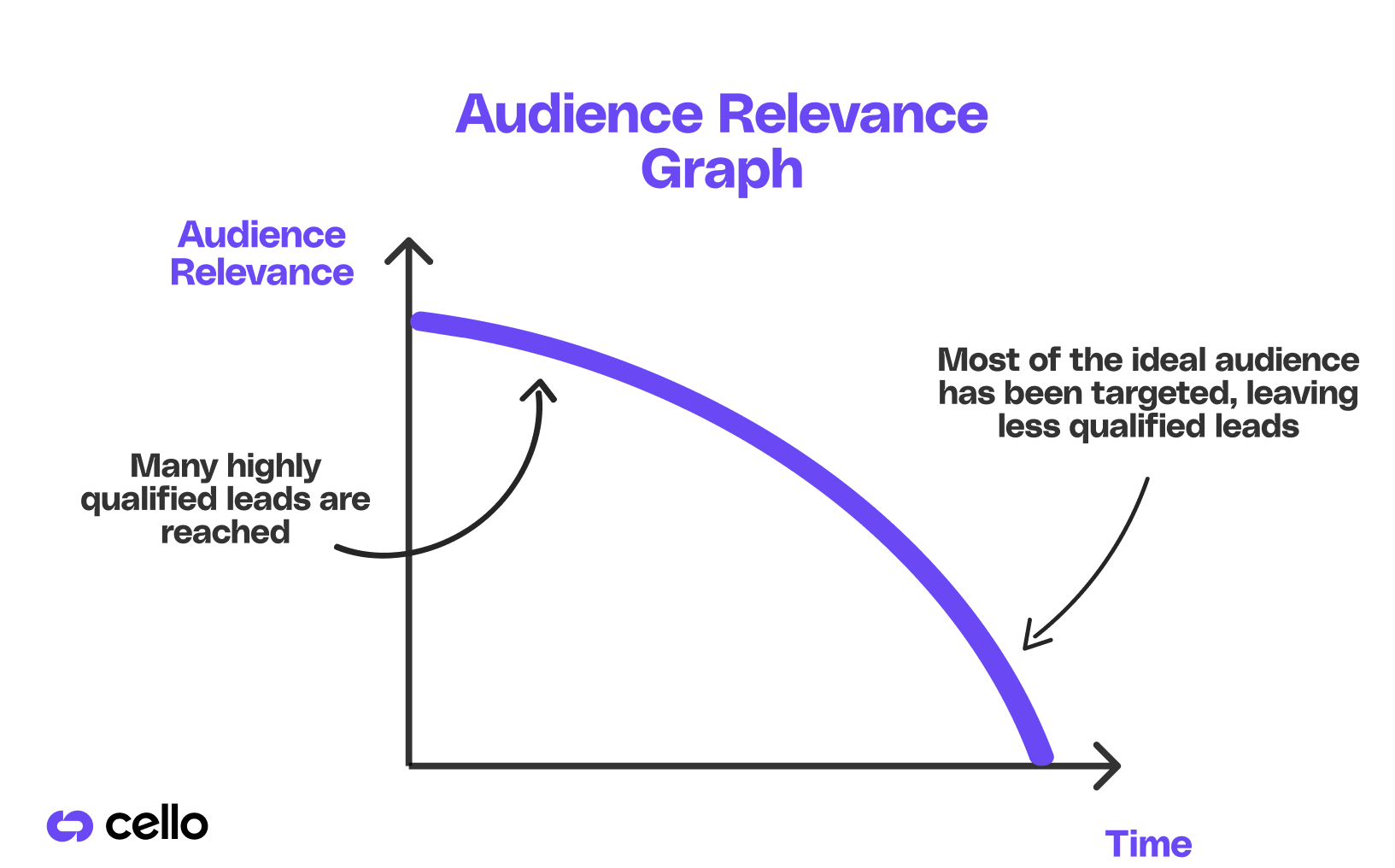
Another key aspect of ad growth loops is minimising the payback period. The shorter this is, the higher the growth in customers, accelerating the cycle of capital reinvestment and growth.
Higher LTVs and more capital are another strategic advantage. More revenue implies that more new audiences can be reached through a variety of channels, as you customer acquisition costs can be higher. Furthermore, the more capital you have available, the more likely you are to outbid competitors for coveted paid channels.
Measuring the success of ad growth loops
Key performance indicators for ad growth loops
Measuring the success of ad growth loops requires the identification and tracking of key performance indicators (KPIs) that align with the overall business objectives.
One advantage of ad growth loops is their small minimum scope - in other words, even when spending smaller amounts on ads, it is possible to get started quickly and to accurately measure their impact.
This is particularly the case for online ads, such as those for social media or SaaS products. The more ads are digital, the easier it is to get ads growth loops started. Growth loops sparked by offline ads require more time and financial investment.
Monitoring some key metrics helps businesses assess the effectiveness of their growth loop and identify areas for optimization.
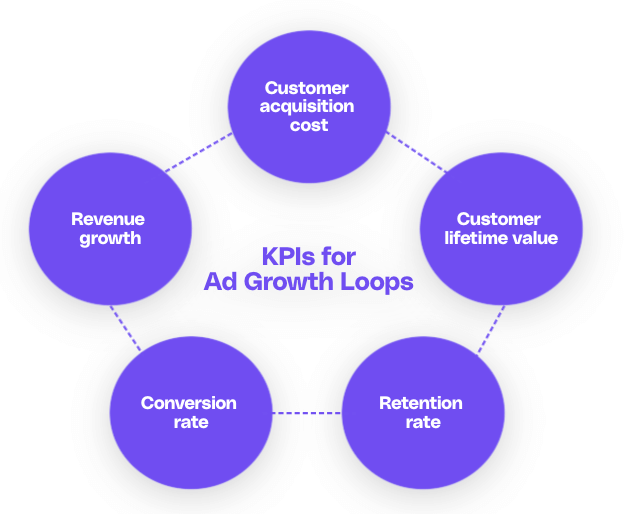
Some common KPIs include:
- Customer acquisition cost (CAC): Shows the cost of acquiring new customers.
- Customer lifetime value (CLV): Reveals how much revenue each customer brings in on average. When compared to CACs, it is a good indicator of the profitability of marketing efforts.
- Retention rate: Indicates what share of customers is retained, thereby providing insights into customer loyalty and satisfaction.
- Conversion rate: Shows the effectiveness of converting leads into paying customers.
- Revenue growth: Reflects the overall financial success of the ad growth loop strategy.
Analyzing the impact of ads
Alongside KPIs, businesses should conduct in-depth analyses to understand the impact of ad growth loops on their overall marketing strategy.
This can involve assessing the following factors.

- Return on ad spend (ROAS): This metric measures the revenue generated for every dollar spent on advertising. Understanding ROAS helps businesses evaluate the profitability of their ad campaigns and allocate budgets effectively.
- User engagement patterns: Analysing metrics such as click-through rates and time spent on site provides valuable information on the effectiveness of ad creatives and messaging.
- Channel analysis: Identifying the most effective channels and messaging strategies helps companies tailor their marketing efforts to maximize engagement and conversions.
By gaining insights into the performance of their growth loop, businesses can make data-driven decisions to optimize their marketing efforts.
Potential challenges and solutions in ads growth loops
While getting started with ad growth loops is quite simple, particularly when digital, there are a few associated challenges.
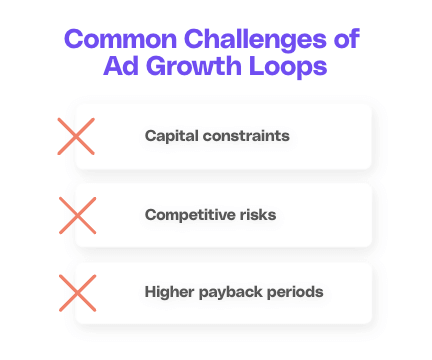
- Capital constraints: Few people are required to get these loops started. However, each additional cycle requires capital to be invested in ads, making the growth loop conditional on continued revenue generation. Having high free-to-paid conversion rates for your users is thus essential.
- Competitive risks: Competitors can see what ads have worked for you and imitate your strategy. It is thus helpful to promote your unique selling points in your ads to stand out from competition.
- Higher payback periods: Over time, there is a risk that the growth loop deviates from your ideal audience to less relevant targets, as most of the former group has been reached. This can extend payback periods, as CACs increase and LTV decreases when lower quality customers are targeted. As a result, less capital can be reinvested, slowing down the loop. The best way to tackle this is by either improving conversion rates of your target audience, or expanding your strategy to include new audiences and other loops.
Future trends in ad growth loops
The role of technology in ad growth loops
As technology continues to advance, its influence on ad growth loops is expected to become increasingly pronounced. Innovations such as augmented reality, virtual reality, and machine learning algorithms have the potential to revolutionize user acquisition, retention, and monetization strategies.
By embracing these technologies, businesses can unlock new opportunities for growth and stay ahead in the competitive landscape.
Augmented reality (AR) and virtual reality (VR) are reshaping the way consumers interact with advertisements. AR allows for immersive brand experiences by overlaying digital content onto the real world, while VR transports users to virtual environments where they can engage with products in a more personal and interactive way.
Machine learning algorithms are enhancing ad targeting capabilities by analyzing vast amounts of data to predict consumer behavior and preferences, enabling advertisers to deliver more relevant and personalized content.
Predictions for ad growth loops in the coming years
The future of ad growth loops holds immense potential. With the rise of personalized advertising, AI-powered automation, and emerging marketing channels, businesses can expect even greater precision and efficiency in targeting their desired audience.
It is anticipated that ad growth loops will continue to evolve and adapt to the ever-changing digital environment, enabling businesses to achieve sustainable growth and stay relevant in an increasingly dynamic marketplace.
Personalized advertising is poised to become the cornerstone of ad growth loops, as consumers increasingly seek tailored experiences that resonate with their individual preferences.
AI-powered automation tools will streamline the ad creation and optimization process, allowing businesses to scale their campaigns and maximize ROI. Emerging marketing channels, such as voice search and social commerce, present new avenues for reaching consumers and driving engagement.
In conclusion, ad growth loops offer a powerful framework for businesses to drive sustainable growth in the digital age. By understanding their definition, mechanics, building strategies, measurement, and future trends, businesses can harness the full potential of ad growth loops to build thriving and profitable enterprises.
Unlock viral growth with Cello's P2P referral programs
Ready to transform your users into a powerful engine for sustainable growth? Cello offers the ultimate solution to supercharge your ad growth loops by turning your users into advocates with our peer-to-peer referral programs. With minimal development time, instant payback from day one, and seamless integration, Cello is designed to make sharing your SaaS product effortless and rewarding. Experience the difference with flexible rewards, real-time performance tracking, and compliance peace of mind. Don't miss out on the opportunity to see how Cello can amplify your growth—Book a demo today and witness the power of user-led growth in action.
Resources
Related Articles

4 Categories of Referral Programs for B2B SaaS
Learn how to get started with referral programs for B2B SaaS. Understand what type of referral ...

Complete Guide to Sales Growth Loops
Discover the power of sales growth loops and how they drive business success.
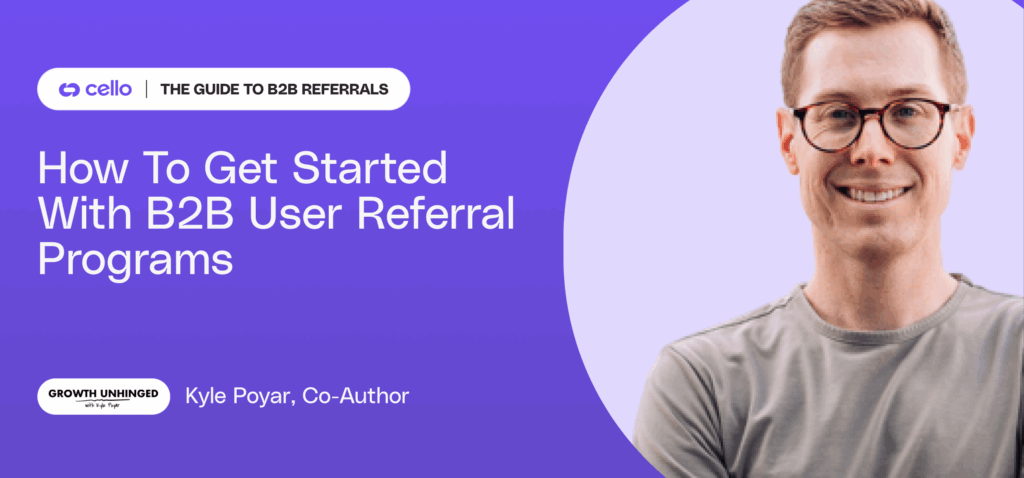
Complete Guide to your B2B Referral Program
Want to get started with B2B referrals? Check out our complete guide to your B2B referral ...

